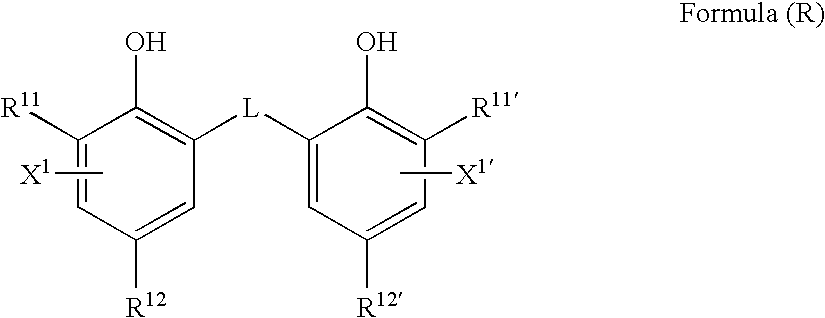Photothermographic material
a technology of photothermographic materials and materials, applied in the field of photothermographic materials, can solve the problems of low transition temperature and other problems, and achieve the effect of improving the condition of the coated surface and high quality imag
- Summary
- Abstract
- Description
- Claims
- Application Information
AI Technical Summary
Benefits of technology
Problems solved by technology
Method used
Image
Examples
synthesis example 1
Synthesis of Exemplified Compound PA-5
[0057] Into a polymerization vessel of gas monomer reaction apparatus (trade name: TAS-2J, manufactured by Taiatsu Techno.), 1500 g of distilled water was poured, followed by heating for 3 hours at 90° C. to form a passive film on a stainless steel-made vessel surface and members of a stainless steel-made stirring device. Subsequently, 582.28 g of distilled water bubbled with nitrogen gas for one hour, 9.49 g of a surfactant (trade name: PIONIN A-43-3, manufactured by Takemoto Oil & Fat Co., Ltd.), 19.56 g of 1 mol / L sodium hydroxide, 0.20 g of ethylenediamine tetraacetic acid tetrasodium salt, 393 g of styrene, 146 g of isoprene, 17.3 g of acrylic acid, and 2.09 g of tert-dodecyl mercaptan were added into the reaction vessel, followed by hermetically sealing. A content therein was stirred at the stirring rate of 225 rpm, followed by heating so that an inside temperature became 65° C. A solution obtained by dissolving 2.61 g of ammonium persulf...
example 1
Preparation of PET Support
(1) Film Manufacturing
[0422] Polyethylene terephtarate (PET) having IV (intrinsic viscosity) of 0.66 (measured in phenol / tetrachloroethane=6 / 4 (weight ratio) at 25° C.) was obtained according to a conventional manner using terephthalic acid and ethylene glycol. The product was pelletized, dried at 130° C. for 4 hours, melted at 300° C. Thereafter, the mixture was extruded from a T-die and rapidly cooled to form a non-tentered film.
[0423] The film was stretched along a longitudinal direction by 3.3 times using rollers having different peripheral speeds, and then stretched along a transverse direction by 4.5 times using a tenter machine. Temperatures used for these operations were 1 10C and 130° C., respectively. Then, the film was subjected to thermal fixation at 240° C. for 20 seconds, and relaxed by 4% along the transverse direction at the same temperature. Thereafter, a chucking part of the tenter machine was slit off, and both edges of the film were ...
example 2
Preparation of Coating liquid for Outermost Layer-2
[0495] A coating liquid for outermost layer-2 was preprared in the similar manner as the outermost layer-1 in Example 1, except that 40 g of innert gelatin and 494 g of 19% by mass of the hydrophibic polymer latex NP-3 having the following composition were used in place of the 100 g of inner gelating and 180 g of a 19% by mass solution of methyl methacrylate / styrene / buty acrylate / hydroxyethyl methacrylate / acrylic acid copolymer (weight ratio of the copolymerization: 57 / 8 / 28 / 5 / 2) latex. Hydrophibic polymer latex NP-3: latex of styrene / butadiene / methacrylic acid copolymer (weight ratio of the copolymerization: 55 / 42 / 3, Tg: 5° C., crosslinking)
[0496] Sample 11 was prepared in the same manner as in sample 3 of Example 1, except that the coating liquid for outermost layer-2 was used in place of the coating liquid for outermost layer-1. Sample 11 was then evaluated in the same manner as Example 1, and it was found that sample 11 also ha...
PUM
| Property | Measurement | Unit |
|---|---|---|
| Tg | aaaaa | aaaaa |
| temperature | aaaaa | aaaaa |
| temperature | aaaaa | aaaaa |
Abstract
Description
Claims
Application Information
 Login to View More
Login to View More - Generate Ideas
- Intellectual Property
- Life Sciences
- Materials
- Tech Scout
- Unparalleled Data Quality
- Higher Quality Content
- 60% Fewer Hallucinations
Browse by: Latest US Patents, China's latest patents, Technical Efficacy Thesaurus, Application Domain, Technology Topic, Popular Technical Reports.
© 2025 PatSnap. All rights reserved.Legal|Privacy policy|Modern Slavery Act Transparency Statement|Sitemap|About US| Contact US: help@patsnap.com



